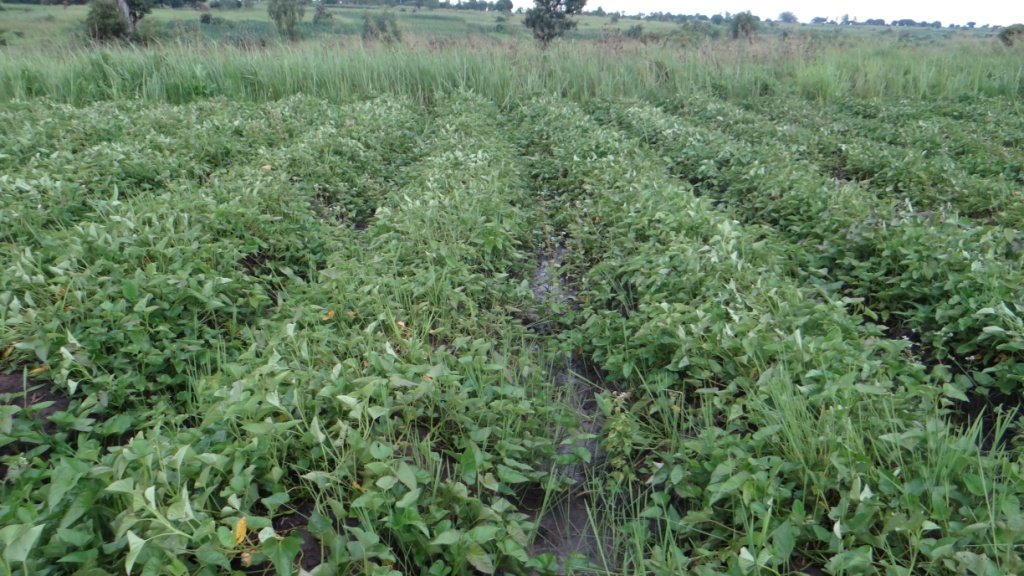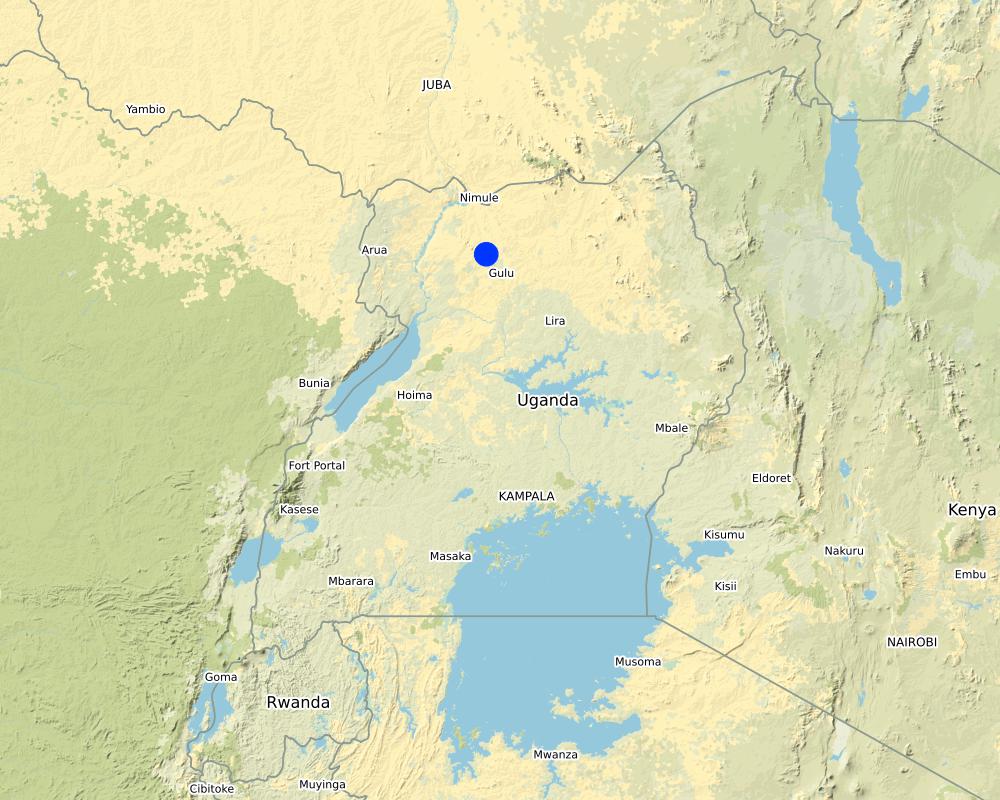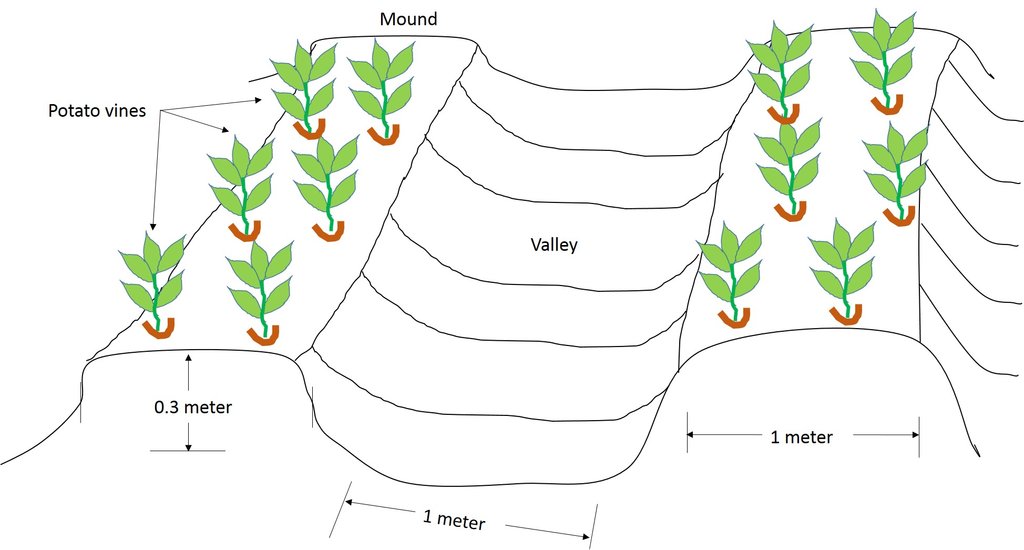Potatoes Gowing in Lowlands for Food Security Durnig Dry Seasons [乌干达]
- 创建:
- 更新:
- 编制者: Bernard Fungo
- 编辑者: JOY TUKAHIRWA, Kamugisha Rick Nelson, betty adoch, Sunday Balla Amale
- 审查者: Nicole Harari, Udo Höggel
technologies_2886 - 乌干达
查看章节
全部展开 全部收起1. 一般信息
1.2 参与该技术评估和文件编制的资源人员和机构的联系方式
关键资源人
土地使用者:
有助于对技术进行记录/评估的项目名称(如相关)
Scaling-up SLM practices by smallholder farmers (IFAD)有助于对技术进行记录/评估的机构名称(如相关)
CDE Centre for Development and Environment (CDE Centre for Development and Environment) - 瑞士1.3 关于使用通过WOCAT记录的数据的条件
(现场)数据是什么时候汇编的?:
25/5/2017
编制者和关键资源人员接受有关使用通过WOCAT记录数据的条件。:
是
1.4 所述技术的可持续性声明
这里所描述的技术在土地退化方面是否存在问题,导致无法被认为是一种可持续的土地管理技术?:
否
2. SLM技术的说明
2.1 技术简介
技术定义:
Lowlands have relatively high water tables and contain sufficient soil moisture to permit potatoes growing. Potatoes can grow in such areas compared to other staple crops like cassava.
2.2 技术的详细说明
说明:
Northern Uganda is mainly semi-arid, receiving rainfall amounts ranging from 600-1000 mm annually. Under these conditions, cultivation of crops is restricted to drought resistant ones such as cassava, sorghum, simsim and ground nuts. Farmers have realized that potatoes are a potential food security crop because they can endure more soil moisture that is available in the lowlands during the dry season. Thus, cultivation of potatoes in wetlands is becoming common because wetlands retain water for longer periods and potatoes, when cultivated, ensure food security during the dry season, a time when other crops are not available, thus bridging the food deficit months.
Sometimes the water in the swamp is more than the potatoes can tolerate. To address this challenge, mounds are made in the garden and the potato vines are planted on the mound rather than in the valley. The size of the mound is approximately one meter wide. The optimum spacing between mounds is also one meter. Potato vines are planted usually at the start of the dry season because this is when the water in the wetlands begins to recede. This is either in June or December. The vines are obtained from neighboring farmers. Weeding is done by manually removing the weeds with either hands or with a hoe. Most of the cultivars in the area are harvested after four months.
The major benefits of this potato growing is to ensure food availability during the dry season when most crops are not available. It also protects the soil as cover-crop, from soil erosion, food security maintaining the tuber for early planting the next season. The major input needed are tuber, labour and land. The benefits of planting potatoes include preventing soil erosion, food and income security. The land user finds the potato crop easy to manage, maturing faster, and being a source of food and income at the same time. Vines from the potato gardens are also used as forage for cows and goats.
2.3 技术照片
2.4 技术视频
日期:
25/5/2017
位置:
Paboo Amuru District
摄影师的名字:
Issa Aliga
2.5 已应用该技术的、本评估所涵盖的国家/地区/地点
国家:
乌干达
区域/州/省:
Northern
有关地点的进一步说明:
Amuru District
Map
×2.6 实施日期
注明实施年份:
2016
2.7 技术介绍
详细说明该技术是如何引入的:
- 通过土地使用者的创新
3. SLM技术的分类
3.1 该技术的主要目的
- 适应气候变化/极端天气及其影响
- 减缓气候变化及其影响
3.2 应用该技术的当前土地利用类型

农田
- 一年一作
主要农作物(经济作物及粮食作物):
Potatoes, maize
3.3 有关土地利用的更多信息
该技术所应用土地的供水:
- 雨养
每年的生长季节数:
- 2
3.4 该技术所属的SLM组
- 轮作制度(轮作、休耕、轮垦)
- 地下水管理
3.5 技术传播
具体说明该技术的分布:
- 均匀地分布在一个区域
如果该技术均匀地分布在一个区域上,请注明覆盖的大致区域。:
- < 0.1 平方千米(10 公顷)
3.6 包含该技术的可持续土地管理措施

管理措施
- M2:改变管理/强度级别
- M4:活动时间安排的重大变化
3.7 该技术强调的主要土地退化类型

土壤水蚀
- Wt:表土流失/地表侵蚀

其它
注释:
Other Land related challenge is climate change in terms of increased dry spells
3.8 防止、减少或恢复土地退化
具体数量名该技术与土地退化有关的目标:
- 适应土地退化
4. 技术规范、实施活动、投入和成本
4.1 该技术的技术图纸
4.2 技术规范/技术图纸说明
Mounds are to be 0.3 m high and 1.0 m wide. On these mounds potato vines are planted.
Conventional crop management practices are followed including weeding and spraying if needed.
4.3 有关投入和成本计算的一般信息
具体说明成本和投入是如何计算的:
- 每个技术区域
注明尺寸和面积单位:
30 meters x 40 meters
其它/国家货币(具体说明):
Uganda Shillings
注明美元与当地货币的汇率(如相关):1美元=:
3500.0
注明雇用劳工的每日平均工资成本:
5000
4.4 技术建立活动
| 活动 | 措施类型 | 时间 | |
|---|---|---|---|
| 1. | Making mounds | 结构性的 | At the start of the season (dry season) |
| 2. | Planting | 农业学的 | Once at the start of the establishment |
| 3. | Weeding | 农业学的 | After one month from planting |
| 4. | Harvesting | 农业学的 | After 5 months from planting |
4.5 技术建立所需要的费用和投入
| 对投入进行具体说明 | 单位 | 数量 | 单位成本 | 每项投入的总成本 | 土地使用者承担的成本% | |
|---|---|---|---|---|---|---|
| 劳动力 | Making mounds | Acre | 1.0 | 200000.0 | 200000.0 | 100.0 |
| 劳动力 | Weeding | Acre | 1.0 | 50000.0 | 50000.0 | 100.0 |
| 劳动力 | Harvesting | Acre | 1.0 | 100000.0 | 100000.0 | 100.0 |
| 植物材料 | Vines | Heaps | 20.0 | 10000.0 | 200000.0 | 100.0 |
| 技术建立所需总成本 | 550000.0 | |||||
4.6 维护/经常性活动
| 活动 | 措施类型 | 时间/频率 | |
|---|---|---|---|
| 1. | Planting | 农业学的 | Once at the start of the establishment |
| 2. | Weeding | 农业学的 | One month after planting |
| 3. | Harvesting | 管理 | Five months after planting |
4.7 维护/经常性活动所需要的费用和投入(每年)
如果可能,按下表分解技术维护费用,并列明各项投入和每项投入的费用。如果您无法分解成本,给出维护该技术的总成本估算。:
50000.0
| 对投入进行具体说明 | 单位 | 数量 | 单位成本 | 每项投入的总成本 | 土地使用者承担的成本% | |
|---|---|---|---|---|---|---|
| 劳动力 | Planting | Acre | 1.0 | 200000.0 | 200000.0 | 100.0 |
| 劳动力 | Weeding | Acre | 1.0 | 100000.0 | 100000.0 | 100.0 |
| 劳动力 | Harvesting | Acre | 1.0 | 150000.0 | 150000.0 | 100.0 |
| 植物材料 | Vines | Heaps | 20.0 | 10000.0 | 200000.0 | 100.0 |
| 技术维护所需总成本 | 650000.0 | |||||
4.8 影响成本的最重要因素
描述影响成本的最决定性因素:
Purchase of tuber during the month of December
5. 自然和人文环境
5.1 气候
年降雨量
- < 250毫米
- 251-500毫米
- 501-750毫米
- 751-1,000毫米
- 1,001-1,500毫米
- 1,501-2,000毫米
- 2,001-3,000毫米
- 3,001-4,000毫米
- > 4,000毫米
农业气候带
- 半湿润
5.2 地形
平均坡度:
- 水平(0-2%)
- 缓降(3-5%)
- 平缓(6-10%)
- 滚坡(11-15%)
- 崎岖(16-30%)
- 陡峭(31-60%)
- 非常陡峭(>60%)
地形:
- 高原/平原
- 山脊
- 山坡
- 山地斜坡
- 麓坡
- 谷底
垂直分布带:
- 0-100 m a.s.l.
- 101-500 m a.s.l.
- 501-1,000 m a.s.l.
- 1,001-1,500 m a.s.l.
- 1,501-2,000 m a.s.l.
- 2,001-2,500 m a.s.l.
- 2,501-3,000 m a.s.l.
- 3,001-4,000 m a.s.l.
- > 4,000 m a.s.l.
说明该技术是否专门应用于:
- 凸形情况
5.3 土壤
平均土层深度:
- 非常浅(0-20厘米)
- 浅(21-50厘米)
- 中等深度(51-80厘米)
- 深(81-120厘米)
- 非常深(> 120厘米)
土壤质地(表土):
- 中粒(壤土、粉土)
土壤质地(地表以下> 20厘米):
- 中粒(壤土、粉土)
表土有机质:
- 中(1-3%)
5.4 水资源可用性和质量
地下水位表:
< 5米
地表水的可用性:
好
水质(未处理):
仅供农业使用(灌溉)
水的盐度有问题吗?:
否
该区域正在发生洪水吗?:
否
5.5 生物多样性
物种多样性:
- 中等
栖息地多样性:
- 中等
5.6 应用该技术的土地使用者的特征
定栖或游牧:
- 定栖的
生产系统的市场定位:
- 混合(生计/商业
非农收入:
- 收入的10-50%
相对财富水平:
- 平均水平
个人或集体:
- 个人/家庭
机械化水平:
- 手工作业
性别:
- 女人
- 男人
土地使用者的年龄:
- 中年人
- 老年人
5.7 应用该技术的土地使用者拥有或租用的平均土地面积
- < 0.5 公顷
- 0.5-1 公顷
- 1-2 公顷
- 2-5公顷
- 5-15公顷
- 15-50公顷
- 50-100公顷
- 100-500公顷
- 500-1,000公顷
- 1,000-10,000公顷
- > 10,000公顷
这被认为是小规模、中规模还是大规模的(参照当地实际情况)?:
- 小规模的
5.8 土地所有权、土地使用权和水使用权
土地所有权:
- 个人,未命名
土地使用权:
- 个人
用水权:
- 个人
5.9 进入服务和基础设施的通道
健康:
- 贫瘠
- 适度的
- 好
教育:
- 贫瘠
- 适度的
- 好
技术援助:
- 贫瘠
- 适度的
- 好
就业(例如非农):
- 贫瘠
- 适度的
- 好
市场:
- 贫瘠
- 适度的
- 好
能源:
- 贫瘠
- 适度的
- 好
道路和交通:
- 贫瘠
- 适度的
- 好
饮用水和卫生设施:
- 贫瘠
- 适度的
- 好
金融服务:
- 贫瘠
- 适度的
- 好
6. 影响和结论性说明
6.1 该技术的现场影响
社会经济效应
生产
作物质量
饲料生产
注释/具体说明:
The vines are used as fodder after harvest of the potato crop
饲料质量
注释/具体说明:
Potato vines are better quality than many grasses especially during the dry season where pastures are scarce
收入和成本
农业收入
收入来源的多样性
工作量
注释/具体说明:
Making mounds is a labor-intensive activity
生态影响
土壤
土壤覆盖层
土壤流失
6.3 技术对渐变气候以及与气候相关的极端情况/灾害的暴露和敏感性(土地使用者认为的极端情况/灾害)
渐变气候
渐变气候
| 季节 | 气候变化/极端天气的类型 | 该技术是如何应对的? | |
|---|---|---|---|
| 年降雨量 | 增加 | 不好 |
6.4 成本效益分析
技术收益与技术建立成本相比如何(从土地使用者的角度看)?
短期回报:
积极
长期回报:
积极
技术收益与技术维护成本/经常性成本相比如何(从土地使用者的角度看)?
短期回报:
积极
长期回报:
积极
6.5 技术采用
- 单例/实验
在所有采用这项技术的人当中,有多少人是自发地采用该技术,即未获得任何物质奖励/付款?:
- 90-100%
6.6 适应
最近是否对该技术进行了修改以适应不断变化的条件?:
否
6.7 该技术的优点/长处/机会
| 土地使用者眼中的长处/优势/机会 |
|---|
| Does not require expert knowledge to be implemented |
| Potato are an important staple crop that farmers rely on for food and income |
| Potato vines can also be used as fodder after harvesting the crop |
6.8 技术的弱点/缺点/风险及其克服方法
| 土地使用者认为的弱点/缺点/风险 | 如何克服它们? |
|---|---|
| Too much sub surface water after the wet season can spoil the subsequent crop due to dumping-off | Avoid planting the crop when the water levels are still high in the lowland |
| Some potato cultivars are sensitive to high moisture content | Select the suitable cultivar to plant in the lowlands, seek advise from extension staff |
7. 参考和链接
7.1 信息的方法/来源
- 实地考察、实地调查
1
- 与土地使用者的访谈
1
链接和模块
全部展开 全部收起链接
无链接
模块
无模块






